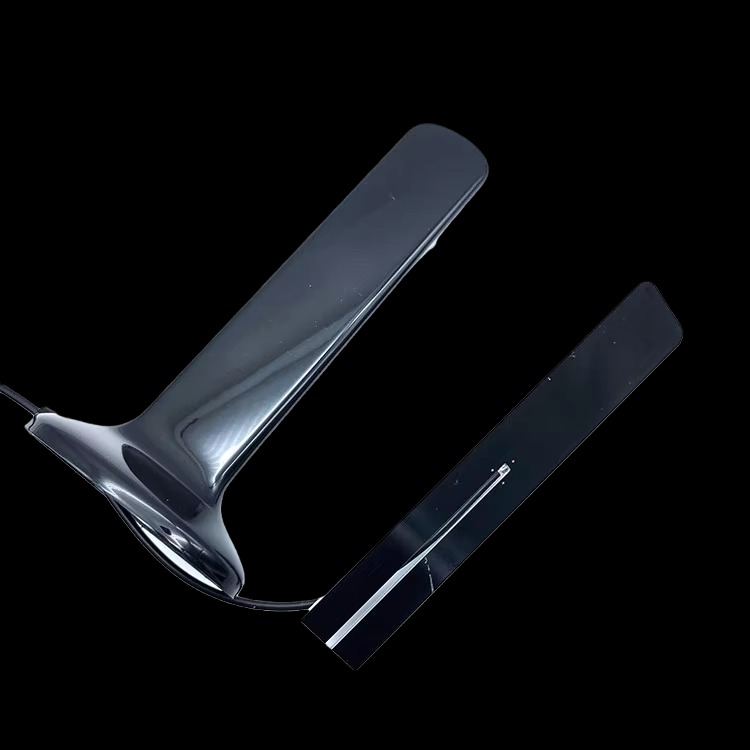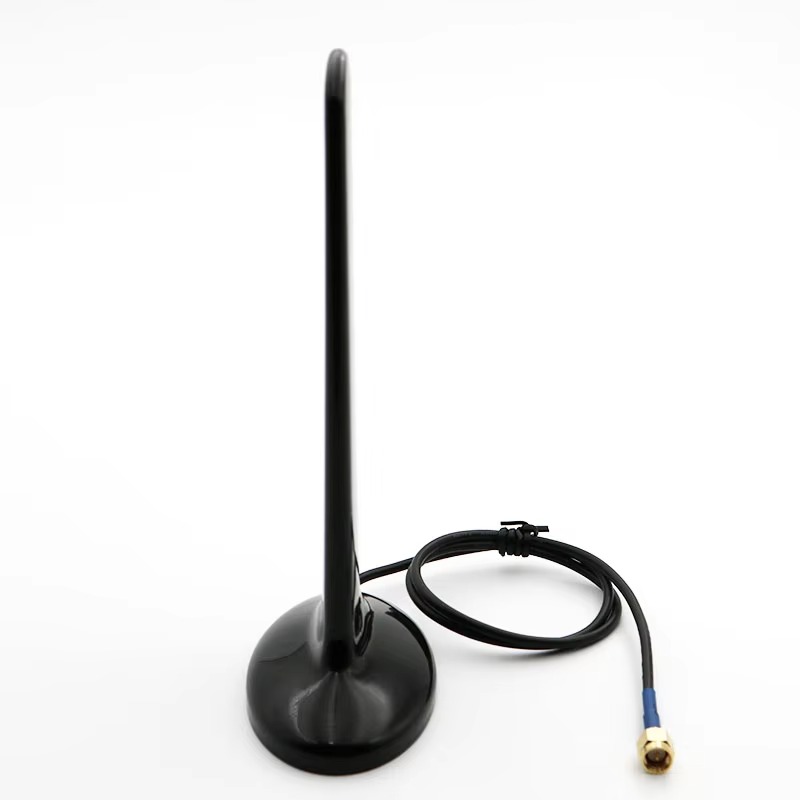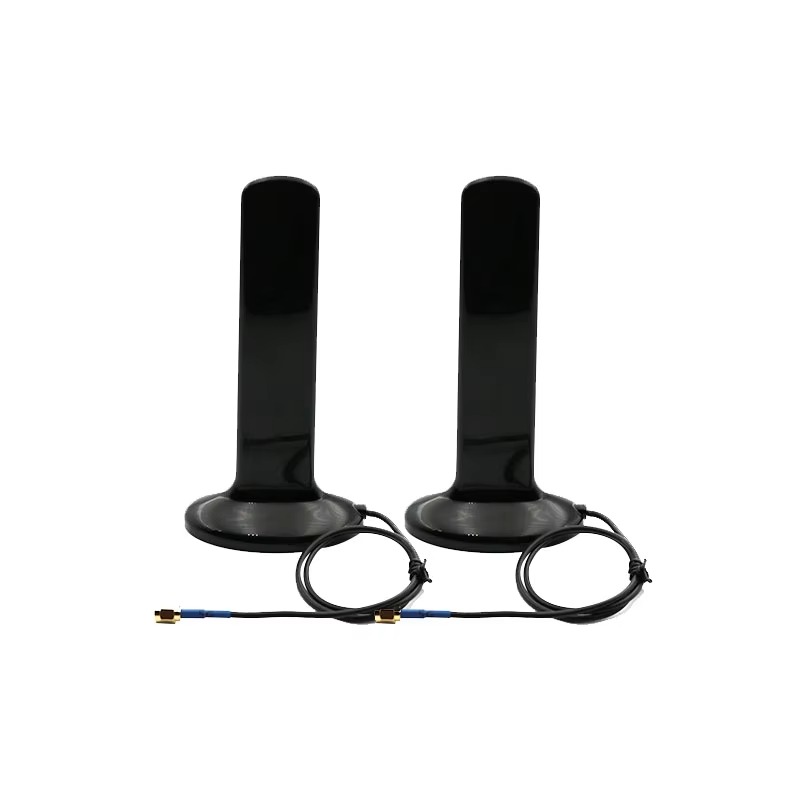At the forefront of the 4G GPS Combo Antenna’s design is its Fakra connectivity, featuring Fakra Male and Fakra Male X3 connectors—a standard in automotive RF systems that ensures secure, low-loss signal transmission. Fakra connectors, developed by Rosenberger, are specifically engineered for automotive applications, offering a robust, keyed design that prevents incorrect mating and ensures consistent performance in high-vibration environments. Unlike generic RF connectors, Fakra connectors incorporate a color-coding system (e.g., red for GPS, blue for cellular) that simplifies installation, allowing technicians to quickly identify and connect the correct signals. The Male X3 configuration supports multiple bands simultaneously, enabling the antenna to handle AM/FM, 4G, GPS, and GNSS signals through separate, dedicated connections. This separation minimizes interference between bands, ensuring that sensitive GPS signals are not corrupted by the stronger 4G or AM/FM transmissions. In a car’s dashboard or roof-mounted setup, where space is limited and vibrations are constant, the Fakra connectors’ secure locking mechanism prevents disconnections, maintaining uninterrupted communication and navigation—critical for features like real-time traffic updates or emergency services (eCall). For automotive manufacturers, Fakra compatibility streamlines production, as it aligns with industry standards, allowing for easy integration into existing vehicle harnesses and infotainment systems.
Constructed from ABS (Acrylonitrile Butadiene Styrene), the antenna is built to withstand the harsh conditions of automotive use, balancing durability, lightweight design, and resistance to environmental stress. ABS is a thermoplastic polymer renowned for its impact strength, chemical resistance, and ability to tolerate extreme temperatures—qualities that make it ideal for housing the antenna’s internal components, including radiating elements, filters, and amplifiers. In a car, the antenna is typically mounted on the roof, trunk, or dashboard, exposing it to a range of challenges: UV radiation from sunlight, temperature fluctuations (from -40°C in winter to +85°C in summer), rain, snow, and road debris. The ABS housing acts as a protective barrier, shielding sensitive electronics from moisture intrusion, corrosion, and physical impacts. For example, in coastal regions where salt spray is prevalent, the ABS material resists rust and degradation, ensuring the antenna remains functional for years. In sunny climates, it resists UV-induced fading or brittleness, maintaining its structural integrity. Additionally, ABS is lightweight, reducing wind resistance and minimizing stress on mounting hardware—a key consideration for fuel efficiency and stability at high speeds. This combination of durability and practicality makes the ABS housing a critical factor in the antenna’s long-term performance in automotive environments.
Dual polarization—vertical for AM/FM and RHCP (Right-Hand Circular Polarization) for GPS/GNSS—ensures optimal signal reception across different frequency bands, adapting to the unique characteristics of each type of transmission. Vertical polarization is ideal for AM/FM radio, as most broadcast towers transmit vertically polarized signals, maximizing signal coupling and reducing interference from horizontal noise sources (such as other vehicles or power lines). This polarization ensures clear radio reception, even in areas with weak signals, such as rural regions or urban canyons where buildings block direct line-of-sight to towers. For GPS/GNSS, RHCP is employed to counteract the Faraday effect, a phenomenon where the Earth’s ionosphere rotates the polarization of satellite signals. By matching the satellites’ RHCP transmission, the antenna captures these signals efficiently, even as the vehicle moves, turns, or changes elevation. RHCP also minimizes multipath interference—signals reflected off buildings, ground, or other vehicles—which often undergo polarization rotation, making them less detectable by an RHCP antenna. This is invaluable for navigation, as it reduces noise and ensures the receiver processes only valid satellite data, maintaining accuracy in dense urban environments or mountainous terrain. The dual polarization design allows the antenna to excel in both radio broadcasting and satellite positioning, a key advantage for a combo unit serving multiple automotive needs.
The antenna’s broad frequency range—covering AM (520-1710 KHz), FM (88-108 MHz), 4G, GPS, and GNSS—ensures comprehensive connectivity, catering to the diverse communication and navigation needs of modern vehicles. AM/FM bands support traditional radio broadcasting, a staple of in-car entertainment, providing access to news, music, and emergency alerts. The 4G band (typically 698-2700 MHz, depending on the region) enables high-speed cellular connectivity, powering features like real-time traffic updates, over-the-air software updates, in-car Wi-Fi, and V2X communication (which allows vehicles to communicate with other cars, infrastructure, or pedestrians). GPS (1575.42 MHz) and GNSS (including GLONASS, BeiDou, and Galileo) bands provide precise positioning data, essential for turn-by-turn navigation, lane-level guidance, and advanced driver-assistance systems (ADAS) such as adaptive cruise control. This multi-band support eliminates the need for separate antennas for each function, reducing clutter in the vehicle and simplifying installation. For example, a car equipped with this antenna can simultaneously stream music via FM, receive real-time traffic via 4G, and navigate using GPS—all without signal interference, ensuring a seamless driving experience.
Optimized gain levels—3 dBi for AM/FM and 28 dBi for GNSS—strike a balance between signal amplification and noise reduction, ensuring reliable performance across each band. Gain measures the antenna’s ability to focus signal energy, and the differing levels are tailored to the unique requirements of each frequency range. For AM/FM, a 3 dBi gain is sufficient to capture broadcast signals, which are typically strong and omnidirectional. Higher gain here would risk amplifying noise (such as engine interference or atmospheric static), degrading audio quality. The moderate gain ensures clear reception without introducing unwanted artifacts, even in areas with moderate signal strength. For GNSS, a much higher 28 dBi gain is employed to amplify weak satellite signals, which travel vast distances through the atmosphere and are often obstructed by buildings, trees, or the vehicle’s metal body. This high gain, combined with a low-noise amplifier (LNA), ensures that even faint signals are boosted to usable levels, enabling the receiver to calculate precise positions. In urban canyons or dense forests, where satellite visibility is limited, the 28 dBi gain becomes critical, ensuring that the navigation system maintains a stable fix. This targeted gain optimization allows the antenna to excel in both entertainment and navigation functions, adapting to the distinct challenges of each.
An impedance of 50 ohms aligns the antenna with industry standards for automotive RF systems, ensuring seamless compatibility with the vehicle’s infotainment unit, 4G modem, GPS receiver, and other components. Impedance matching is crucial for maximizing power transfer and minimizing signal reflection, which can cause interference and reduce efficiency. A mismatch between the antenna and connected devices can lead to signal loss, reduced gain, and increased noise—all of which compromise radio quality, cellular connectivity, or navigation accuracy. By adhering to the 50-ohm standard, the antenna ensures that signals are efficiently transmitted across all bands, from the low-frequency AM signals to the high-frequency 4G and GNSS bands. This compatibility simplifies integration into existing vehicle systems, as most automotive RF components (such as coaxial cables, amplifiers, and receivers) are designed for 50-ohm interfaces. Whether connected via the Fakra connectors to the car’s head unit or to an aftermarket navigation system, the 50-ohm impedance ensures consistent, high-quality signal transfer.
A VSWR (Voltage Standing Wave Ratio) of ≤1.5 underscores the antenna’s efficiency in transferring signal power across all bands, minimizing loss and maximizing performance. VSWR measures the mismatch between the antenna’s impedance and the 50-ohm characteristic impedance of the transmission line (coaxial cable), with lower values indicating better efficiency. A VSWR of ≤1.5 means that over 96% of the signal power is transferred from the antenna to the receiver (or vice versa), with minimal reflection that could cause interference or reduce range. This efficiency is maintained across the entire frequency range, ensuring consistent performance whether the antenna is receiving an AM radio signal, transmitting 4G data, or capturing GPS coordinates. For example, when streaming music via FM radio, the low VSWR ensures that the signal is transmitted with minimal loss, resulting in clear audio. When using 4G to download a map update, the efficient power transfer ensures a fast, stable connection, even in areas with weak cellular coverage. For GPS, the low VSWR ensures that the amplified weak signals are efficiently processed by the receiver, maintaining positioning accuracy. This level of efficiency is particularly important in automotive applications, where space constraints limit the size of antennas, making every decibel of signal power critical.
The use of RG174 coaxial cable enhances the antenna’s performance and flexibility in automotive installations, ensuring low signal loss and reliable connectivity. RG174 is a small-diameter, lightweight coaxial cable designed for high-frequency applications, making it ideal for routing through a vehicle’s tight spaces—such as between the roof and dashboard, through door jambs, or under carpet. Its construction includes a solid copper-clad steel center conductor for efficient signal transmission, a dielectric insulator to minimize loss, a braided copper shield to block electromagnetic interference (EMI), and a PVC outer jacket for durability. The braided shield is particularly important in automotive environments, where EMI from the engine, alternator, infotainment system, and other electronics can corrupt RF signals. By blocking EMI, the shield ensures that AM/FM, 4G, and GPS signals remain clean and free from noise, preserving audio quality and navigation accuracy. The PVC jacket is resistant to abrasion, oil, and temperature extremes, ensuring that the cable remains reliable even when exposed to harsh conditions—such as contact with engine components or exposure to sunlight. For installers, the flexibility of RG174 simplifies routing, allowing the antenna to be mounted in optimal positions (like the roof for unobstructed GPS reception) while connecting to the head unit in the dashboard.
A DC voltage requirement of 12V DC aligns with the standard electrical system of most vehicles, ensuring easy integration and reliable power for the antenna’s active components. Cars typically operate on a 12V electrical system (with occasional fluctuations), making 12V the ideal voltage for powering the antenna’s low-noise amplifiers (LNAs) and other active electronics. The LNA for GNSS, which boosts weak satellite signals, requires a stable power source to maintain its gain and noise figure—critical for preserving the 28 dBi gain performance. By using 12V DC, the antenna can draw power directly from the vehicle’s electrical system, eliminating the need for additional voltage converters or batteries. This simplifies installation, as the antenna can be connected to the car’s fuse box or head unit power supply, ensuring that it is powered whenever the vehicle is on. The 12V requirement also ensures compatibility with a wide range of vehicles, from compact cars to trucks and SUVs, making the antenna a versatile solution for automotive manufacturers and aftermarket installers.
The 4G GPS Combo Antenna’s applications in cars are diverse, spanning entertainment, navigation, communication, and safety. For infotainment, it enables AM/FM radio reception, providing drivers and passengers with access to music, news, and emergency broadcasts—a fundamental feature of in-car entertainment. The 4G connectivity powers in-car Wi-Fi, allowing passengers to stream content, browse the internet, or work on the go, while also enabling the vehicle to receive over-the-air updates for maps, software, and infotainment features. GPS and GNSS support deliver precise navigation, with turn-by-turn directions, lane guidance, and real-time traffic updates that help drivers avoid congestion and reach their destinations efficiently. In advanced vehicles, the antenna supports ADAS features such as lane-keeping assist and automatic emergency braking, which rely on accurate positioning data to function safely. For fleet management, the 4G and GPS capabilities enable real-time tracking of vehicles, allowing managers to monitor routes, optimize fuel efficiency, and ensure driver safety. Additionally, the antenna’s 4G connectivity supports eCall (emergency call) systems, which automatically dial emergency services and transmit the vehicle’s location in the event of an accident—potentially saving lives.
The antenna’s performance in challenging automotive environments is a key advantage, ensuring reliability even in conditions that would disrupt less robust systems. In urban areas, where tall buildings block GPS signals and reflect cellular waves, the high GNSS gain and RHCP polarization minimize multipath interference, maintaining navigation accuracy. The 4G band’s broad frequency range ensures connectivity even as the vehicle moves between cell towers, preventing dropped calls or interrupted data transfers. In rural regions, where radio and cellular signals are weaker, the antenna’s optimized gain levels amplify these signals, ensuring that AM/FM radio remains clear and 4G connectivity is maintained for critical features like emergency calls. In extreme weather—rain, snow, or fog—the ABS housing protects internal components, while the RG174 cable’s shielded design prevents moisture-related interference. For off-road vehicles, the antenna’s durable construction withstands vibrations and impacts, ensuring that navigation and communication remain functional in rugged terrain.
Looking to the future, as vehicles become more connected and autonomous, the role of the 4G GPS Combo Antenna will expand to support emerging technologies. The integration of 5G capabilities—building on the antenna’s 4G foundation—will enable faster data transfer, lower latency, and support for V2X communication, which is essential for autonomous driving. The antenna’s multi-band design can be extended to include new GNSS constellations (such as BeiDou or Galileo) and higher-frequency bands, ensuring compatibility with global navigation systems. For electric vehicles, the antenna’s lightweight design and low power consumption will contribute to energy efficiency, aligning with the industry’s focus on sustainability. Additionally, as cars become part of smart city ecosystems, the antenna will play a key role in enabling vehicles to communicate with traffic lights, parking systems, and other infrastructure, optimizing traffic flow and reducing congestion.




































































 Language
Language
 En
En Cn
Cn Korean
Korean

 Home >
Home > 







 18665803017 (Macro)
18665803017 (Macro)













